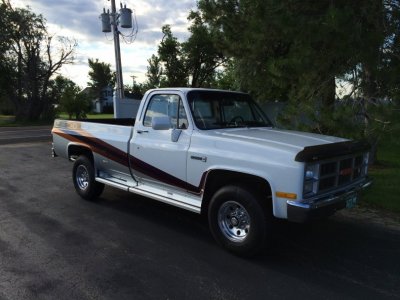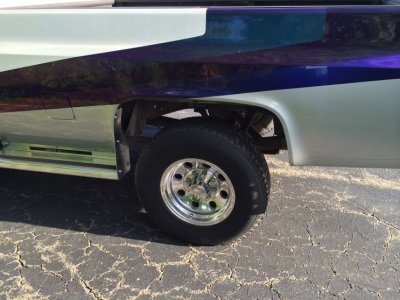CoMtGuy
Junior Member
- Joined
- Aug 23, 2014
- Posts
- 19
- Reaction score
- 4
- Location
- Colorado
- First Name
- Gregg
- Truck Year
- 1983
- Truck Model
- GMC K2500
- Engine Size
- 350 M Code
I'm new here.... I'm curious about timing. I have an 83 GMC K2500 with an M code engine 8600 GVWR so minimal emissions gear, just a smog pump, dont see any EGR, no O2 sensor etc. QuadraJet carb.
My emission label says 4 degrees BTC (dist plugged off).
When I bought the truck my engine was after firing and popping out the exhaust. It stunk of raw fuel idling. I put in new plugs, wires, dist cap, rotor, new ECV's, new ICM, and replaced vac hoses where needed. I found the timing at about 12 degrees, and set it back to 4 degrees per the label. I adjusted the 2 idle mixture carb screws to lean it out, by dropping off the idle (turning in) 200 rpm then re-setting the idle speed screw to 700rpm like the label said. It idles better, starts easier and sets high idle pretty easy, doesn't want to come off high idle until temp reaches above 180, then kicks down easy enough, but I still have after firing only until the engine reaches temp, and when the engine is warm I get popping/gurgling in exhaust on initial accel in each gear. I can let off the throttle slightly and popping stops then accelerate and it goes smoothly up to high rm with no popping, with an occasional pop between gears when letting off the throttle during clutching. This makes me think the timing is off, that as soon as I let the mechanical decrease when letting off the throttle the advance drops and stops the popping... like it's too far advanced, which leads me to believe my label is perhaps not enough BTDC for my engine.
My question is... why does the label say 4 degrees BTDC when everything I read here says 8-12?! Should I push the timing to 8-12 and see if the after firing while cold (and popping between gears when warm) disappears?
My emission label says 4 degrees BTC (dist plugged off).
When I bought the truck my engine was after firing and popping out the exhaust. It stunk of raw fuel idling. I put in new plugs, wires, dist cap, rotor, new ECV's, new ICM, and replaced vac hoses where needed. I found the timing at about 12 degrees, and set it back to 4 degrees per the label. I adjusted the 2 idle mixture carb screws to lean it out, by dropping off the idle (turning in) 200 rpm then re-setting the idle speed screw to 700rpm like the label said. It idles better, starts easier and sets high idle pretty easy, doesn't want to come off high idle until temp reaches above 180, then kicks down easy enough, but I still have after firing only until the engine reaches temp, and when the engine is warm I get popping/gurgling in exhaust on initial accel in each gear. I can let off the throttle slightly and popping stops then accelerate and it goes smoothly up to high rm with no popping, with an occasional pop between gears when letting off the throttle during clutching. This makes me think the timing is off, that as soon as I let the mechanical decrease when letting off the throttle the advance drops and stops the popping... like it's too far advanced, which leads me to believe my label is perhaps not enough BTDC for my engine.
My question is... why does the label say 4 degrees BTDC when everything I read here says 8-12?! Should I push the timing to 8-12 and see if the after firing while cold (and popping between gears when warm) disappears?



